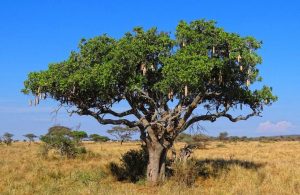The use of medicinal plants as a fundamental component of the African traditional healthcare system is one of the oldest and the most assorted of all therapeutic systems. Medicinal plants are the most easily accessible and affordable health resource available to the local communities.
One of such highly valued medicinal plants is Sarcocephalus latifolius (Smith) – the African peach which belongs to the plant family ‘Rubiaceae’. The generic name of this plant is derived from two Greek words; Saco (fleshy) and Cephalus (headed), in reference to the shape of the flowers. It is a savannah tree or shrub which is up to 12m high, with a twisted trunk up to 30cm in diameter, spreading a multi-stemmed open canopy. The stem is a cracked, dark grey-brown with a fibrous reddish slash. Leaves are shiny, dark green on the upper surface, paler below, and a wide oval. Flowers have a terminal spherical head like cymes. The fruit is syncarp, round, warted, red and can be as large as oranges, containing many seeds embedded in its pinkish flesh.
The Sarcocephalus latifolius plant is widely distributed in a number of African countries including, but not limited to, Uganda, Cameroon, Congo, Gabon, Zaire, Benin, Cote D’Ivoire, Gambia, Ghana, Guinea, Guinea-Bissau, Liberia, Mali, Nigeria, Senegal, Sierra Leone, and Togo.
The use of this species of Rubiaceae in traditional African medicine for a given disease condition varies from one traditional setting to another. All the parts of Sarcocephalus latifolius have been used in one way or the other for a given health condition within a particular community. However, the effective use of any of its parts greatly depends on the season and time of harvest. For instance, the most effective roots in treating diseases are mostly harvested during the dry season in the evening hours, while the most effective leaves are also mostly harvested during the dry season but during the morning hours, instead.
The Sarcocephalus latifolius herbal remedy preparations can be in the form of a decoction or as an infusion. It can also be ground into powder and mixed with soup or milk and then drunk. In some cases, the juice/sap from the plant parts is extracted by pounding or direct chewing by the patient.
The leaf decoction of Sarcocephalus latifolius is used by traditional healers as a remedy for diabetes, malaria fever, constipation, and pyomyositis. In the coast of West Africa, the patients suffering from diarrhoea and dysentery are treated by letting them eat the leaves of Sarcocephalus latifolius together with melegueta pepper, followed by a drink of warm water. In addition, the leaf decoction is mixed with honey and taken as a beverage to cure abdominal or indigestion conditions. In some instances, the leaf juice extract is boiled in water and the resultant infusion rubbed on the affected skin parts to treat rashes and body swellings.
The bark decoction is useful in the treatment of wounds, jaundice, coughs and is also prescribed as a mouth wash. In a number of communities, a cold infusion from the stem bark is used to regulate bowel functions, treat common digestive system problems and relieve bad tastes due to indigestion.
The tree bark of Sarcocephalus latifolius is chewed as an antiseptic for mouth disorders and also to treat mouth abscesses. A bitter yellow cold infusion prepared from the bark, known at one time as ‘African quinine’, is used as a febrifuge, and a tonic, as well as an anthelmintic remedy. The deep yellow stem bark extract can also used to dye skin. The finely pulverised bark is applied to heal wounds.
The root of Sarcocephalus latifolius is used in treatment of venereal disease and wounds. The root decoction preparation is used as anticonvulsant, anxiolytic, antihypertension, as well as a laxative. The root powder decoction can also be used to treat a hernia. In West Africa, the bitter root is administered to treat digestive disorders. The paste made from roots is applied to treat skin rashes. A decoction either from the whole root or from the macerated soft center of the root is taken to relieve indigestion conditions. In addition, just as with the stem bark, the root decoction is also used as a febrifuge and tonic.
Apart from the medicinal properties, the edible fruits are gathered from the wild especially by children for local use and are often sold in local markets. The fruits, eaten in many communities have an acidic taste and the aroma similar to a peach. They can be eaten fresh or in dried form. The fruits can be eaten, as well as a medicinal remedy. The Sarcocephalus latifolius plant is also used as arrow poison, source of food, domestic fuel, and timber for building.
The healing ability of Sarcocephalus latifolius has made it attractive in the African herbal markets and from its wide use, it is evident that this medicinal plant has a significant role in traditional healthcare delivery in many communities and will most likely continue to play vital roles in the health care systems for generations to come.
– Komakech Richard and Omujal Francis






